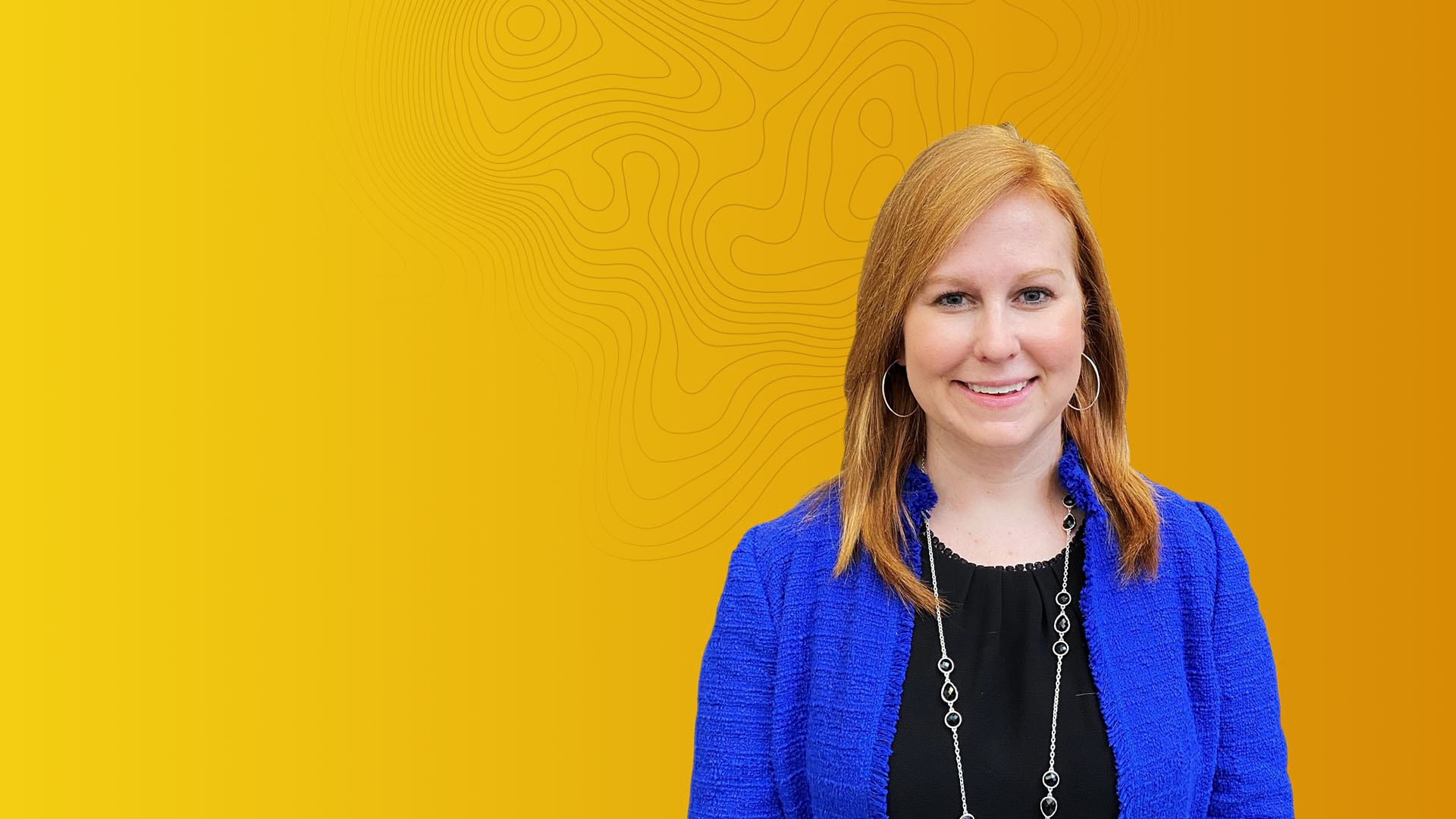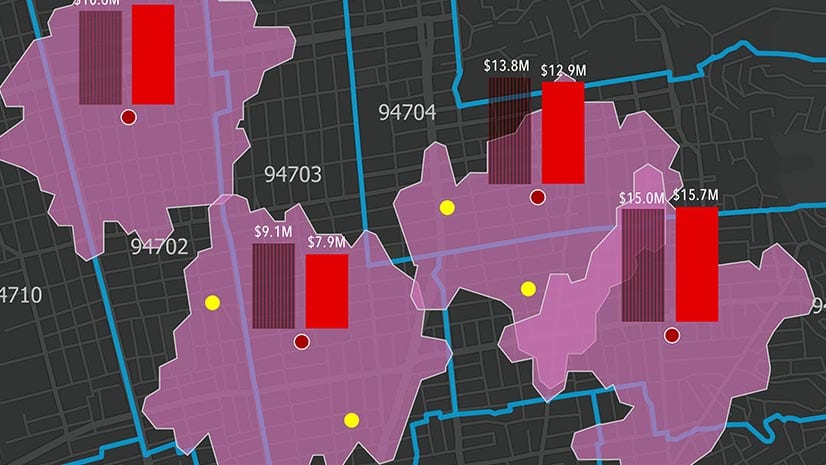Seven years ago, Beth Rogers was seriously pursuing an academic career in science that included studying the camouflage techniques of cuttlefish in the depths of the Indian Ocean.
It was under the sea, in the world of bottom-dwelling peacock flounders and octopus-like creatures, that she first felt the lure of a life dedicated to scientific research. Yet that quiet underwater environment could not have been more removed from the rough-and-tumble retail world of Fruit of the Loom, where Rogers eventually wound up and now thrives as the senior manager of data science.
Although her career change was less philosophical than economical, Rogers has found her own intellectually stimulating niche at Fruit of the Loom. She now heads a data science team bringing data-driven decision-making to the forefront of the 169-year-old company through the use of location intelligence, data analytics, and geographic information system (GIS) technology.
The approach is gaining traction, especially after one project helped generate an estimated 20 percent savings in shipping costs. Now, not only are more departments asking for her team’s advice, but large retailers that sell Fruit of the Loom products have also requested their insight as well.
“I just kind of happened to be in the right place at the right time to become a catalyst for data science,” says Rogers, who arrived at Fruit of the Loom when company leaders were looking for a data-driven edge on the competition.
Sudden Move to Garment Company Bears Fruit
Rogers earned a master’s degree in geoscience at Western Kentucky University (WKU), with a concentration in GIS technology. Between her first and second years at WKU, with the school’s funding for summer work in question, Rogers found herself looking for an internship. When her search turned up an opening at Fruit of the Loom headquarters in her hometown of Bowling Green, Kentucky, Rogers was taken aback.
Although the parents of several of her friends had worked for the company, she had never considered a job in business—let alone at one of the best-known brands in the retail world. She also knew that some in academia viewed business research as rushed, or incomplete.
But she applied and earned the job. Once inside, Rogers found managers on a quest to topple information silos—looking for ways to leverage vast stores of data amassed through the company’s global reach. That intrigued her.
“I’m a lifelong learner,” she says, “and I like to soak up information from the experts and the practitioners.” So, she dove in.
One of the first things Rogers discovered at Fruit of the Loom was that a business does not have time for open-ended research projects. Analysis had to be done thoughtfully but quickly—and communication was key. She learned to tell the story of her research on GIS-based smart maps, showing colleagues location intelligence that could help the business.
Rogers was excited to realize that the company’s data was so extensive it held a treasure trove of possibilities, especially if she could blend Fruit of the Loom data with that of its other properties, including Russell Athletic, Spalding, and Vanity Fair lingerie.
She also couldn’t help but recognize that, rather suddenly, her career had gone from underwater to underwear. By some measures, it was a strange turn of events, but it was fascinating nonetheless. “Cuttlefish camouflage does certainly sound very different than Fruit of the Loom underwear,” Rogers says today. “But at the core of it are all those processes and skill sets I had learned in order to distill data, attack research questions, and formulate hypotheses. Reliable data science in retail is based on the same scientific process I studied in college.”
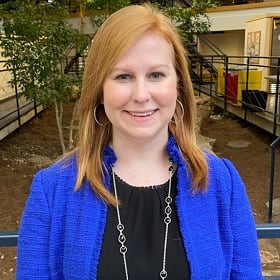
Everyone can understand—if they have a little bit of geography—a map and what it is representing. And for me, that was just so powerful. Using those maps, especially initially, was a way for me to get in the door and open the world of possibilities to these teams.
Data Science as a Secret Weapon
Back when Rogers applied for an internship, Chris Krebs, Fruit of the Loom’s CIO, was already looking for ways to speed his company’s digital transformation.
“Everybody in retail is looking for an edge, and everybody is looking for that opportunity to improve,” Krebs says. “When we eventually built the team around Beth, it was about building a data science capability in the company to analyze business problems, to see things from a different perspective, and to think with data.”
Rogers’s internship turned into a full-time position and, eventually, a leadership role as head of data science at Fruit of the Loom. As the efforts of the data-science team grew and department leaders came asking for help, Krebs realized that people without business school training could indeed uncover crucial insights in massive amounts of business data.
“We are leveraging these people’s talents as they come out of school and work on real business problems, using their math and data science skills to produce fresh insights,” Krebs says. “We need a wide diversity of people who can sift through all this data and see things other people don’t see.”
Seeing Patterns in Seas of Data
For Rogers and Fruit of the Loom, data science and location intelligence proved their worth quickly. She and her team found a way to save on shipping costs by streamlining supply chains and relocating products to a different distribution center location.
“A lot of people were looking at our supply chain on spreadsheets or maybe very rough maps,” Rogers says of her early days at the company. “From spreadsheets, you’re not going to be able to understand any spatial context. And I think that was just so important—making that move to spatial visualization and getting more and more teams interested.”
Rogers and the team also used location intelligence to pinpoint how many degrees the temperature must drop before people head to stores or online in search of winter wear. They studied how that weather-related tipping point can vary by region (see the image at left for an example). For a business that sells through online channels and brick-and-mortar retailers, understanding customer preferences in different locations proved particularly valuable.
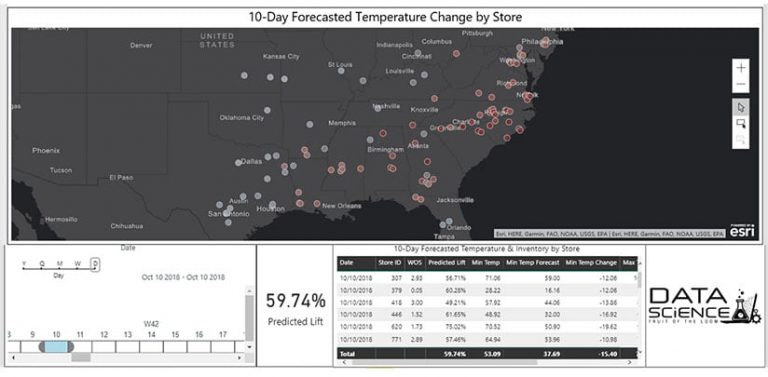
But in a market with thin margins and many competitors, an edge is hard to come by. Perhaps because of that, Krebs remains cautious about discussing some of the work Rogers and her team perform. “I kind of look at that little team as a secret weapon,” he tells WhereNext. “I want to try to keep some of that to ourselves.”
He is more talkative about Rogers’s ability to understand business needs and her skill in telling the story of data science and location intelligence—not through traditional spreadsheets but through smart maps and simulations that can empower business decision-makers with greater clarity and confidence.
“She thinks about things differently [and] brings a totally different perspective, a very analytical approach to solving problems,” Krebs says. “She’s very insightful, which is particularly important in this field, and I think she does a nice job explaining their findings and telling that story around data science so that nonscientists and sales and marketing strategists can understand and buy in.”
Going against Tradition and Intuition
Rogers’s initial lack of business experience brought a new dimension to the work. For one, it gave her a critical view of traditional practices and conventional thinking.
“I really wanted to help leaders make the best decision based on what the data was telling them” she says.
She and her team used data science and location intelligence to surface sometimes counterintuitive conclusions. One discovery was that while marketing reps often want their products in every store possible, a more effective strategy is to tailor each store’s inventory to the tastes of local customers.
“It’s not intuitive to tell sales or marketing that their product may be less productive the more stores it is in,” says Jeff Lynn, Fruit of the Loom’s vice president of category management and business analytics.
With GIS technology, the team analyzed how a product sold in certain stores, and where it was successful. “Then the next group of stores we’d roll it out to would be stores that matched that consumer profile,” Lynn says. “And that’s really where we started to get more traction with how to use this [technology] to expand distribution to the right areas.”
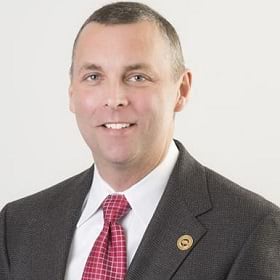
A particular store in a particular market and a particular demographic might have different inventory needs than another store in a different demographic in a different state.
Creating Data Science Dashboards for the Nonscientist
After proving how data science produces winning strategies, Rogers’s team is now poised to deliver self-serve dashboards that allow nonscientists to use the data. A self-serve model for business insight and location intelligence is something other industry leaders are also warming to. This helps free the data science team to conduct deeper analysis rather than respond to recurring requests.
“Beth is driving a lot of automation in the analytics that we do,” Lynn says. “I think she’s really a driving force to help us all advance in how we use more data in real time to make critical business decisions.”
While intuition occasionally leads to success, in the digital age it’s becoming harder for companies to invest in a strategy that has not been checked against data, Lynn says.
“I think the work that Beth and her team does allows us the opportunity to operate more intelligently,” Lynn says. “And the more we can do with information and the faster we can get that information and make decisions, I think the stronger we’re going to be as an organization, not only for ourselves but for our retail partners.”

Beth has been able to take data streams from different areas to pull them all together. And I think that's where the benefit comes in, because the power of the analytics is much better when you've got all the combined data in one spot.
The Future of Data Science and Data Scientists
Rogers remains in touch with her academic friends and mentors, and she talks to college students about geoscience and location intelligence and their practical applications in business.
But she has no regrets about blazing her own trail, or any hesitancy about recommending the corporate world to science-minded colleagues. A recent study shows that geoscience jobs are paying very well.
“I hope all of my friends continue in their science careers and do amazing research,” she tells WhereNext. “But I think I’ve been able to be an example for people who now see that you can bridge over from academia into industry.”
To encourage younger students to consider STEM careers, Rogers teaches special Super Saturday classes for third and fourth graders about undersea life. “That also helps me explain my career journey to them, and the young students seem to think it’s kind of neat to be in the room with a scientist,” she says. “But I’m also someone who has applied her knowledge and created a job and career out of it in the private sector.”
Rogers wants the grade schoolers to know they can do the same and that career paths sometimes have jagged turns. CIO Krebs would probably agree.
“If everybody is turning right, Beth is that one that says, ‘Maybe we ought to turn left,’” Krebs says. “Her ideas make me think of a new way to approach something. You never leave a meeting with her without learning a whole bunch of things or without thinking about issues in a different way.”
So what does the future hold for the senior manager of data science?
“I wouldn’t even put a box around that,” Krebs says. “She’s one of those people who can do what she wants. I think she’s learned a lot here, and I could see her running the company someday.”
Listen to a recent podcast to learn more about Beth Rogers and Fruit of the Loom, and visit this Forbes article for details on how a company creates a data-based culture.
The Esri Brief
Trending insights from WhereNext and other leading publicationsTrending articles

December 5, 2024 |

July 25, 2023 |

November 12, 2018 |

April 1, 2025 |

April 29, 2025 |

February 1, 2022 |
